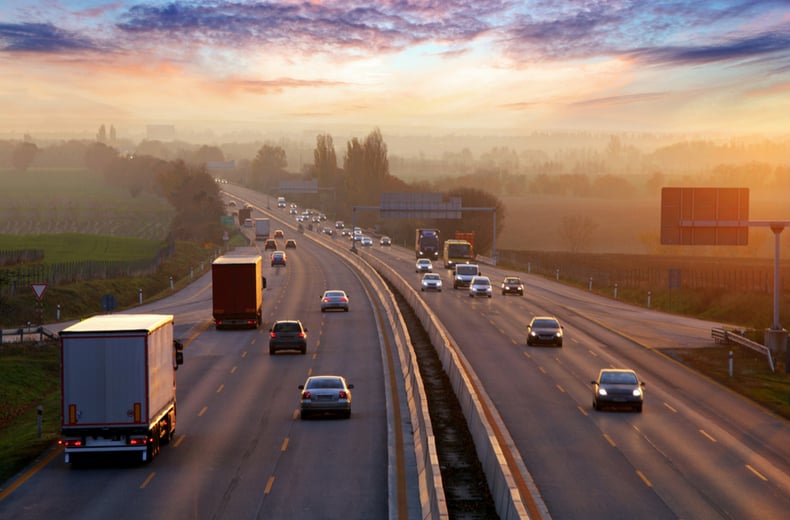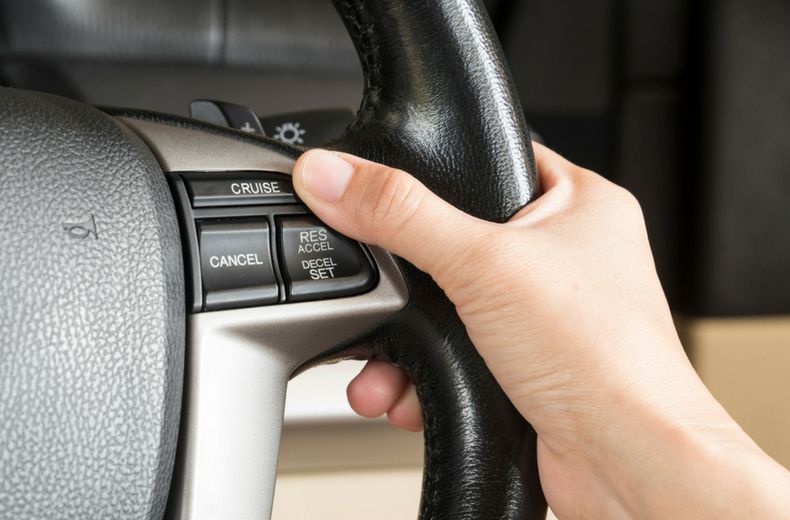In this essential guide, we explain everything you need to know about how and when to use it.

SALE – up to 40% off*
Roadside & Recovery from £5.29 a month*
• Cheaper than AA Price Promise or we’ll beat by 20%^
• We get to most breakdowns in 60 mins or less
• Our patrols fix 4/5 breakdowns on the spot

How does cruise control work?
Cruise control is an electronic system that enables you to fix a vehicle’s accelerator on a specific speed, so you can take your foot off the pedal.
It’s basically a form of driving on auto-pilot.
Cruise control is designed to be used on A-roads and motorways that don’t have frequent stops and turns to negotiate.
At one time it was only found on high-end luxury cars, but now even the smallest city cars frequently have it fitted.
It’s activated through pressing buttons while you’re driving. The main controls are ‘on/off’, ‘set’, ‘cancel’ and ‘resume’.
Modern-day cruise control was invented in 1948 by blind American mechanical engineer Ralph Teetor, although speed control has its roots in the 18th century when it was used to regulate steam engines.
How to set cruise control

Cruise control is slightly different on each model of vehicle, but most systems work in a very similar way. Follow these 5 steps to start cruising:
1. Build your speed: Cruise control is designed for driving at a steady speed of at least 30 mph without constant stopping, so it’s ideal for a motorway or dual carriageway.
2. Switch on cruise control: Once you reach your desired speed (making sure it’s within the speed limit), turn on the cruise control system. In most vehicles, the buttons that control it appear on or behind the steering wheel, and a light will appear on your dashboard once it’s turned on.
Important: Before using cruise control for the first time, check your handbook and locate the buttons so you’re not fumbling around trying to find them while on the road – which is clearly dangerous.
3. Set the cruise control: Once you’ve switched the system on, press the set button. This will communicate with your car to hold the current speed. In most vehicles, this will turn the dashboard indicator green. After the cruise control is set, you can remove your foot from the accelerator and the car should maintain its speed.
4. To accelerate: Most cars will have either an ‘up’ arrow or ‘+’ button to allow you to raise the car’s speed. Pressing the accelerator pedal will normally override the system.
5. To decelerate: Either tap the down arrow or ‘-‘ button on the cruise control system, or apply the brake. For safety reasons, cruise control will be deactivated as soon as the brake is applied.
Other functions: The ‘cancel’ button pauses cruise control, giving you full control again without the system fully switching off. It should retain the speed you choose to cruise at.
If you want to return to your previously programmed speed, just press ‘resume’.
Does cruise control save money?
The primary function of cruise control is to make driving more comfortable, but by smoothing out acceleration and deceleration you can save fuel too.
Many of us would admit that we’re not very consistent in maintaining a steady speed on the road, even on motorways.
Constantly accelerating and braking will use significantly more fuel than maintaining a set speed.
According to the Department for Transport, driving at a steady speed of 50 mph instead of 70 mph can improve fuel economy by 25%.
Additionally, setting your cruise control to the speed limit can help you avoid speeding fines.
It can be especially helpful in today’s driving climate as average-speed cameras are becoming increasingly common.
When shouldn’t you use cruise control?
.jpg)
While cruise control has many benefits, there are times when it is not safe to use. Avoid cruise control:
In heavy traffic, on winding roads, going downhill and when approaching a bridge. Basically, whenever a constant speed is impractical.
On slippery roads – that includes snow, ice, heavy rain and hailstorms – as this increases the chances of sliding.
Late at night or when you feel tired. Cruise control can soon become snooze control. Because you don’t have to keep your foot on the accelerator, it’s easier to nod off – and lose control of your vehicle.
What is adaptive cruise control?
Some of today’s cars are equipped with adaptive cruise control (ACC).
Adaptive cruise control is a more advanced technology that enables you to set a specific speed while the system automatically reads the traffic ahead and keeps your car at a safe following distance.
It does this by using radar sensors mounted at the front of the car so your speed matches that of the vehicle in front.
When the system senses a change in the distance to the car ahead, it will automatically brake or accelerate to maintain the cruising speed you previously set. Clever or what?
If the car in front suddenly speeds off, however, your car won’t routinely follow it. Instead, the ACC system will hold the pre-set speed until you change it, or it catches up with another vehicle.










